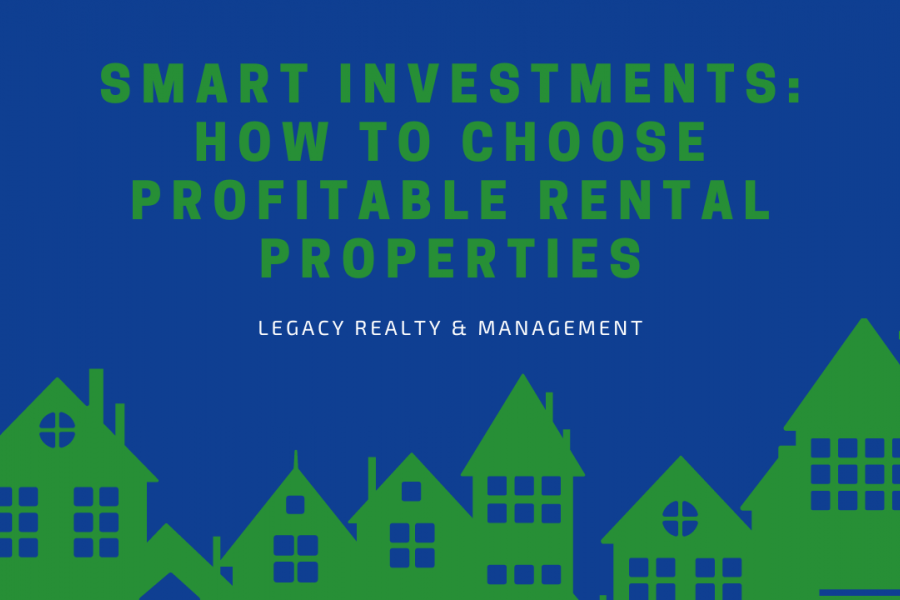
- Research the Local Rental Market Trends
- Consider the Property's Location and Proximity to Amenities
- Evaluate the Property's Condition and Potential for Renovations
- Calculate Potential Rental Income Versus Expenses
- Assess the Neighborhood's Growth Potential
- Look for Properties With Low Vacancy Rates
- Consider the Demographic of Potential Tenants
- Evaluate the Property's Appreciation Potential
- Factor in Property Management Costs and Responsibilities
- Perform Thorough Due Diligence, Including Inspections and Financial Analysis
- Conclusion
With a potential for long-term appreciation and a consistent flow of passive income, investing in rental properties may be quite profitable. But not every rental property is made equal, and picking the correct one can have a big impact on your ability to succeed financially.
In this article, Legacy Realty and Management, a reputable real estate company, shares valuable insights on how to identify profitable rental properties for smart investments.
1. Research the Local Rental Market Trends
Conducting thorough research on the local rental market is crucial for making informed investment decisions. Start by analyzing the average rental rates for different property types, such as single-family homes, apartments, or condominiums, to understand what tenants are willing to pay in the area.
Examine the occupancy rates across the region, as high occupancy rates typically indicate strong demand and low vacancy rates, which can translate to consistent rental income.
Study real estate metrics like population growth trends, job market dynamics, and local economic factors that influence the demand for rental properties. Historical data can also provide valuable insights into the market's stability and potential for future growth or decline.
2. Consider the Property's Location and Proximity to Amenities
Location is often the single most crucial factor that determines a rental property's desirability and potential rental income. Properties situated in prime locations, with easy access to major employment centers, shopping districts, parks, and recreational facilities, are highly sought after by tenants.

Proximity to public transportation, major highways, and other conveniences can also significantly enhance a property's appeal and attract a wider pool of potential tenants. Evaluate the surrounding area's safety, walkability, and overall quality of life, as these factors can directly impact tenant satisfaction and retention.
3. Evaluate the Property's Condition and Potential for Renovations
The condition of a rental property plays a pivotal role in its profitability and long-term success. A well-maintained property that requires minimal renovations can generate rental income more quickly, but it may also come with a higher initial purchase price.
Conversely, properties in need of updates or renovations can present an opportunity for increasing value and commanding higher rents after improvements are made. Conduct a thorough inspection of the property's structural integrity, including the foundation, roof, and load-bearing walls, to identify any potential issues that may require significant repairs.
Evaluate the condition of essential systems, such as plumbing, electrical, and HVAC, and assess the need for upgrades or replacements.
4. Calculate Potential Rental Income Versus Expenses
Before committing to a rental property investment, it's essential to conduct a comprehensive financial analysis. Estimate the potential rental income based on comparable market rates and factor in all associated expenses, such as mortgage payments, property taxes, insurance premiums, maintenance costs, and vacancy rates.

Ensure that the projected rental income provides a positive cash flow after accounting for all expenses, including a contingency fund for unexpected repairs or vacancies. A thorough financial projection will help you determine the property's potential profitability and return on investment.
5. Assess the Neighborhood's Growth Potential
Investing in a neighborhood with strong growth potential can significantly impact your investment's long-term success. Look for areas with planned infrastructure improvements, such as new transportation routes, commercial and residential developments, and positive demographic trends like population growth and increasing household incomes.
These factors can contribute to increased property values, higher rental demand, and a thriving local economy over time. Research the area's zoning regulations, future development plans, and any potential barriers to growth.
6. Look for Properties With Low Vacancy Rates
Low vacancy rates are a strong indicator of a healthy rental market with consistent demand. Properties in areas with high occupancy rates are likely to experience fewer periods of vacancy, ensuring a steady stream of rental income and reducing the risk of prolonged vacancies.
However, it's essential to analyze the reasons behind low vacancy rates, such as a shortage of rental properties or a transient population, to ensure long-term sustainability.
7. Consider the Demographic of Potential Tenants
Understanding the demographic of potential tenants is crucial in tailoring your property to meet their specific needs and preferences. For example, families may prioritize proximity to parks and family-friendly amenities, while young professionals may value access to public transportation, entertainment options, and a vibrant social scene.

Identifying your tenant demographic and catering to their preferences can help you attract quality tenants, minimize turnover, and maximize rental income.
8. Evaluate the Property's Appreciation Potential
While rental income is the primary source of revenue for investment properties, long-term appreciation can also contribute significantly to your overall return on investment. Factors such as the area's economic growth, job prospects, housing demand, and the property's condition and potential for improvements can influence its appreciation potential.
Conduct a thorough analysis of these factors to gauge the likelihood of capital appreciation and ensure your investment aligns with your long-term financial goals.
9. Factor in Property Management Costs and Responsibilities
Managing a rental property can be a complex endeavor, requiring specialized knowledge and expertise. Consider the costs and responsibilities associated with property management, such as advertising vacancies, screening tenants, handling maintenance requests, collecting rent, and ensuring compliance with local regulations.
Hiring a professional property management company like Legacy Realty and Management can alleviate these tasks and ensure your investment is well maintained while freeing up your time to focus on other aspects of your financial portfolio.
10. Perform Thorough Due Diligence, Including Inspections and Financial Analysis
Before finalizing any rental property investment, it is imperative to conduct comprehensive due diligence. This includes hiring qualified professionals to perform inspections and assessments of the property's condition, including structural integrity, systems functionality, and potential hazards.

Thoroughly review financial documents, legal contracts, zoning regulations, and any potential liabilities or encumbrances associated with the property. A detailed financial analysis, including projected cash flows, returns on investment, and sensitivity analyses, should be conducted to ensure the investment aligns with your financial goals and risk tolerance.
Conclusion
Investing in profitable rental properties requires a strategic approach and careful consideration of various factors. By following the guidelines outlined in this article, you can increase your chances of identifying smart investment opportunities that align with your financial goals.
Legacy Realty and Management understands the complexities of real estate investing and offers invaluable expertise to guide you through the process. With our extensive market knowledge, professional property management services, and commitment to client success, we can be a trusted partner in your journey to building a successful rental property portfolio.
Contact us today to get started!
